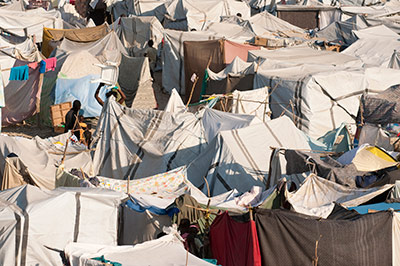
Brad Kieserman was 10 years old when Hurricane Agnes struck Wilkes-Barre, Pa., his hometown. The storm engulfed the city in floodwaters from the swollen Susquehanna and Lackawanna rivers, destroyed 7,000 buildings, and left tens of thousands of people homeless. In the 52 years since then—many of them spent responding to countless emergencies for the Red Cross, the U.S. Coast Guard, and other agencies—Kieserman had never seen a disaster quite like it.
That is, until late September of 2024 when Hurricane Helene hit a broad swath of the Southeastern United States, and Kieserman, now Vice President for Disaster Operations and Logistics for the American Red Cross, traveled to Western North Carolina to help rescue workers there. What he saw reminded him of Agnes; yet, in some ways, it was even more disturbing.
“You’ve got tens of millions of gallons of water pouring down off a 6,500-foot high mountain range, and that is across 9,000 square miles of terrain,” says Kieserman, who is also an instructor in the Executive Master’s in Humanitarian Crisis & Emergency Management program at Georgetown University. “It literally erased whole communities. You didn’t even know there were homes in some of these places, because it just swept everything away.”
“You can build a defense against a river,” Kieserman says, recalling Hurricane Agnes and how Wilkes-Barre was unprepared. “What defense do you build against mountains?”
A New Set of Challenges
Georgetown’s executive master’s program is responding to a worldwide trend—fueled by climate change and global conflict—of more, and more frequent, disasters. As a result, emergency managers have to deal with long-term humanitarian effects and needs in addition to their traditional roles as emergency responders. Kieserman says these “consecutive and concurrent disasters”—hurricanes, wildfires, and deadly heat waves, to name a few—have resulted in “a chronic disaster environment.”
“In the 1980s, in the United States, we had about three disasters a year where the insured loss is $1 billion or more,” Kieserman says. “Last year, we had 28 of those types of disasters. At this pace, we are in ‘continuous response.’”
This new reality requires emergency managers who are up-to-date on the field’s latest technology and skilled at working with affected populations in both the short and long term.
The Executive Master’s in Humanitarian Crisis & Emergency Management program is a 12-month cohort-based program focusing on topics such as natural disaster recovery, strategic leadership, terrorism and weapons of mass destruction, global health and pandemics, and humanitarian crisis management. Participants will complete five residencies, two online and three in person, located in Tokyo, Japan; Doha, Qatar; and Geneva, Switzerland.
The executive degree program prioritizes data analysis and the creative use of emerging technologies. At the same time, it stresses the human dimension of this global phenomenon, including the need for intercultural awareness and ethical decision-making. For several years, Kieserman has taught the course Ethics & Critical Decision Making at Georgetown, which explores the ethical responsibilities all disaster managers have to themselves, organizations, the government, and the public.
As more and more people are displaced around the globe by both natural and manmade disasters, the need for this new kind of emergency management is only going to increase, Kieserman says.
“Humanitarian disaster relief is a profession that requires an intense commitment to a series of strategies and tactics that need to be mastered,” he says. “It’s not a pick-up game. We’re talking about the needs of millions and millions of people.”
